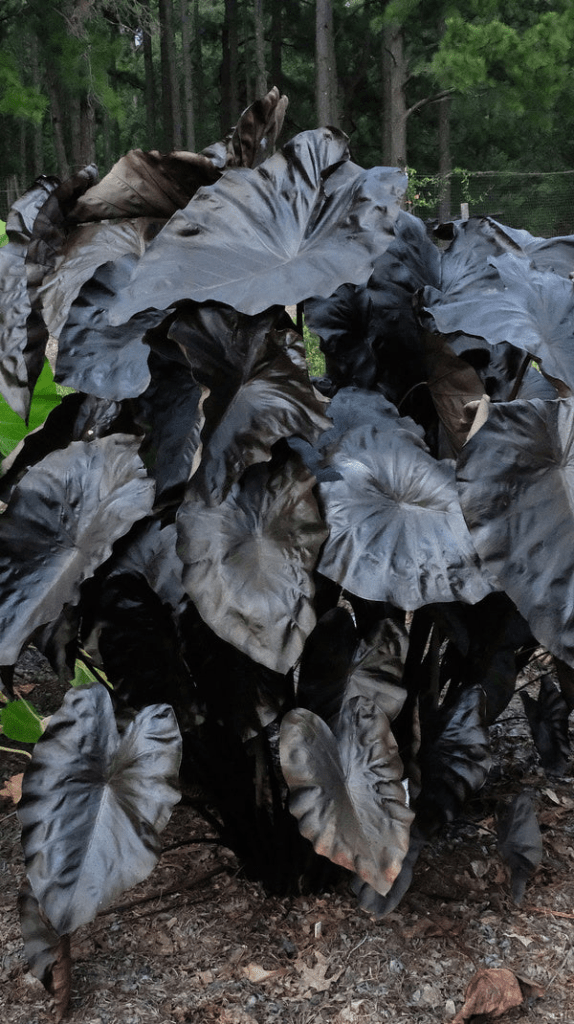Welcome to our guide on the Black Elephant Ears, specifically the Colocasia Hawaiian Black Coral variety. This stunning plant is celebrated for its large, dark foliage that adds a touch of drama to both outdoor gardens and patio spaces. Explore the unique features of the Colocasia Hawaiian Black Coral, learn how it thrives outdoors and as a patio plant, and discover essential care instructions and planting directions to cultivate a striking botanical display.

Growing Outdoors
The Colocasia Hawaiian Black Coral, also known as Black Elephant Ears, is prized for its bold, almost black, heart-shaped leaves. Here’s how it thrives as an outdoor garden plant:
1. Foliage Drama:
The Hawaiian Black Coral variety features large, dark leaves that create a dramatic and tropical ambiance in your garden. The striking color contrast adds visual interest to any landscape.
2. Sunlight Preferences:
Plant the Black Elephant Ears in a location with partial to full shade. While it can tolerate some sun, providing dappled or filtered sunlight enhances the dark coloration of the leaves.
3. Soil Conditions:
Provide well-draining, rich soil with a slightly acidic to neutral pH. Amending the soil with organic matter enhances fertility and promotes robust growth.
4. Watering:
Keep the soil consistently moist but not waterlogged. Elephant Ears appreciate regular watering, especially during dry periods. Mulching around the base helps retain moisture.
5. Maintenance:
Remove any damaged or yellowing leaves regularly to maintain the plant’s appearance. Mulch around the base to suppress weeds and regulate soil temperature.
Growing as a Patio Plant
The Black Elephant Ears can be grown in containers, making it a striking addition to your patio or balcony. Here’s how to cultivate it as a patio plant:
1. Container Selection:
Choose a large container with drainage holes to accommodate the Elephant Ear’s root system. Opt for a container that complements the plant’s size and provides stability.
2. Potting Mix:
Use a well-draining potting mix rich in organic matter. Adding perlite or sand can improve aeration and drainage, ensuring optimal conditions for container growth.
3. Sunlight on the Patio:
Place the potted Black Elephant Ears on your patio in a location with filtered sunlight or partial shade. Protect the plant from intense afternoon sun to prevent leaf scorch.
4. Watering in Containers:
Container plants may dry out more quickly, so monitor soil moisture regularly. Water when the top inch of the soil feels dry, ensuring proper drainage to prevent waterlogging.
Care Instructions
Ensuring the health and vibrancy of your Colocasia Hawaiian Black Coral involves paying attention to several key care aspects:
1. Fertilization:
Feed your Elephant Ears with a balanced fertilizer during the growing season (spring and summer). Follow the manufacturer’s recommendations for application rates.
2. Pest Control:
Keep an eye out for common pests such as aphids or spider mites. Treat any infestations promptly with insecticidal soap or neem oil.
3. Winter Protection:
In colder climates, lift the rhizomes of the Black Elephant Ears before the first frost. Store them in a cool, dry place and replant them in the spring.

Planting Directions
Follow these planting guidelines to ensure a successful establishment of your Colocasia Hawaiian Black Coral:
1. Site Selection:
Choose a partially shaded area for outdoor planting. For patio plants, select a large container with proper drainage.
2. Planting Depth:
Plant the rhizomes or potted Elephant Ears at a depth of 2 to 3 inches. Space multiple plants about 24 inches apart for outdoor cultivation.
3. Watering After Planting:
Water the newly planted Elephant Ears thoroughly to settle the soil. Maintain consistent moisture during the growing season.
4. Mulching:
Apply a layer of organic mulch around the base of outdoor plants to retain moisture, suppress weeds, and regulate soil temperature.
By following these care instructions and planting guidelines, you can enjoy the bold and exotic beauty of the Colocasia Hawaiian Black Coral in your outdoor garden or on your patio. Embrace the dark foliage and tropical allure of this impressive plant, making it a standout feature in your outdoor living spaces.


